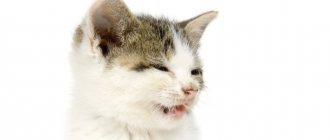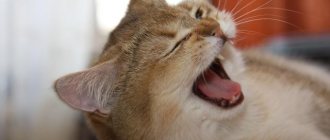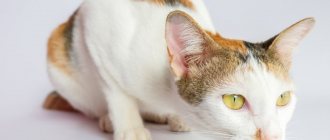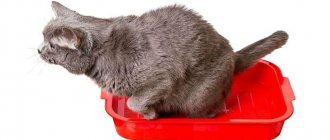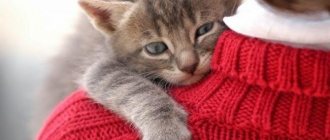13256Administration
1
Many owners often wonder why their cat sneezes and his eyes water. Some consult with a veterinarian, others try to overcome it on their own by washing the eyeball with herbal or tea infusions, while others hope that it will go away on its own.
Often the owner still pays attention to the fact that the animal is sneezing. If it sneezes due to dust particles getting into the nasal passage, then there is no need to worry. But when a runny nose and sneezing become permanent, it is necessary to figure out why the animal is sneezing and eliminate the disease.
Tears in animals perform a protective function, which is similar to the processes occurring in humans. Tears appear if dust or speck gets in. This is normal. But if the cat behaves restlessly and the flow of tears continues for a sufficient time, then this process must be stopped.
© shutterstock
If a cat’s eyes are watery and sneezing at the same time, then these are good reasons to seek help from a doctor.
Causes
What should you do if your cat sneezes and his eyes water?
Watery eyes and sneezing can occur either from ordinary litter or from a serious infection. Therefore, at the first symptoms, it is recommended to see a specialist.
The most common reasons why a cat's eyes are watery are:
Allergy . This phenomenon is quite common. Allergic reactions can be caused by various household products, perfumes, deodorants, pollen, mold, and even cat litter.
It often happens that a baby sneezes on his own fur , which ends up in various organs. Irritation and fluid discharge from the eyes can be caused by blood-sucking insects: mosquitoes and fleas.
In case of allergies, you need to find sources and methods to eliminate them.
- Conjunctivitis . Many bacteria and infections can cause inflammation of the organ mucosa. Conjunctivitis is accompanied by itching, the eyelids become swollen, and pus may drain from the eyes. With complex manifestations of this disease, fever may appear. The cat will be weak. There may also be a lack of appetite.
- Children's age of a cat . Strong production of tears is typical for newborn kittens who have opened their eyes for the first time. Usually the mother cat does the washing. But if she is not nearby, then the kitten’s eyes should be wiped with boiled water or an infusion of weak tea.
- Breed personality . There are special breeds of cats, such as Persians, Britons and Sphynxes, in which lacrimation occurs due to their anatomical shape of the eyes and structure of the skull. Such animals require careful care.
- Weakened immunity . Such cats are more often exposed to diseases and infections. Often with the following symptoms: sneezing, coughing, watery eyes. To strengthen the immune system and to never hear the animal sneeze, you should get special vaccinations and monitor the cat’s diet.
- Infectious diseases . The eyes are watery, the pet is sneezing - all this can occur with the following infections: chlamydia, calcivirosis, rhinotracheitis and others. Some of them are transmitted by airborne droplets, so the owner is at risk of becoming infected. To prevent various infections, as well as to avoid identifying the reasons why your friend is sneezing and his visual organs are watery, it is recommended to vaccinate the animal on time.
- Eye diseases . Of these, glaucoma and cataracts are well known. These are very serious illnesses that appear due to improper metabolism and can lead to loss of vision in a cat. In the early stages, the disease is quite easy to recognize. At a later stage, the cat’s vision decreases, the lens becomes cloudy, and lacrimation appears.
- Helminths . When cats develop worms, vomiting, diarrhea, lack of appetite, and excessive lacrimation are possible.
- Eye damage . If a cat has an injury in the area of these organs and they are tearing a lot, then it is necessary to inspect this area. If the wound is not severe, then simply treating it with Furacilin solution will help. For severe bruises, you should consult a doctor.
Treatment of cats
Once on the nasal mucosa, the virus penetrates the cells of the body, causing the cells to die. This is how inflammation begins. Also, general deterioration and fever are caused by viruses that have entered the bloodstream.
For the successful recovery of your furry pet, comprehensive treatment and proper care are necessary. The veterinarian will prescribe treatment based on the general condition of the patient. Experts do not recommend taking various medications on your own. This can only worsen the patient's condition.
In addition to taking special medications, the following recommendations will be useful:
- Isolation of a sick animal from healthy ones;
- Mandatory disinfection of the place where the sick pet lies;
- Drink warmly and avoid hypothermia;
- Cleaning the nose and eyes with antiseptics daily;
- If you refuse to eat, you need to force-feed the patient to avoid liver lipidosis (accumulation of fat);
- Gentle, liquid food: fish, meat, cereals and milk;
- The use of vitamin preparations, for example: Gamavit;
- Use of immunostimulating drugs: Imunofan, Fosprenil, Salmozan;
- Complex therapy includes the use of antiviral drugs: Acyclovir, Lysine, Gamapren;
- Antibiotics should be used if there is a manifestation of secondary infections, for example: Flemoxin, Sumamed, Cefazolin.
If you treat your cat correctly and follow all the recommendations of a professional, the animal’s condition will improve in 8-10 days.
The disease rhinotracheitis leads to a decrease in immunity. This leads to various negative consequences:
- The chronic stage is dangerous for the development of pneumonia, intestinal atony, damage to the nervous system, subsequent exacerbations of the disease, and the development of secondary infections;
- An advanced form of the disease can lead to damage to the eyeballs so that they have to be removed;
- In particularly severe cases, the disease leads to the death of the animal. Most of all, this threatens kittens and young individuals due to weak immunity;
- More than 80% of animals remain carriers of the infection after recovery.
Thus, a cat that has had rhinotracheitis is a source of infection for its kittens. The virus infects the animal's uterus. Therefore, miscarriages, various pathologies and deformities in newborns most often occur with infected cats. The virus is excreted in feces and urine for quite a long time, for 1.5 years.
When is help needed?
If your animal has the following symptoms, then a trip to the veterinarian is required:
- the cat is constantly sneezing;
- his eyes are watering;
- no appetite;
- irritation and itching in the area of the visual organ;
- purulent discharge;
- the eyes became a different color and became cloudy;
- the animal is very lethargic or, on the contrary, overexcited;
- There are deep wounds and cuts.
The doctor will conduct an examination and prescribe the right treatment, thanks to which you will not hear or see your baby sneezing or his eyeballs watering.
Symptoms of the disease
The reaction develops rapidly; signs of angioedema in children are swollen lips, neck, and face. The upper torso, hands, feet, and genital area are often affected. Quincke's edema is visible in the eyes of a child - the eyelids swell on one or both sides.
- When the tonsils are affected, the picture is similar to a sore throat.
- Edema of the larynx is indicated by a hoarse voice, difficulty breathing, a gusty cough, blue discoloration and then gradual paleness of the skin.
- Swelling that appears in one area may occur in another. This mainly applies to large-scale swelling.
- When the mouth and tongue swell, speech becomes difficult.
- If the process is localized in the gastrointestinal tract, the child may complain of tingling of the tongue, followed by diarrhea and vomiting, and sharp pain in the intestinal area.
- Rarely, swelling of the meninges occurs. With it, the child cannot fully tilt his head forward, complains of a headache, and behaves inhibited. Convulsions and vomiting may occur.
- If only the skin is affected, joint pain, fever may appear, and the child may lose consciousness.
The pathological condition can last from an hour to several days.
How does angioedema begin in a child?
Immediately after contact with the allergen, the listed symptoms increase sharply. This happens in a matter of minutes. Source: G. I. Smirnova. Urticaria and Quincke's edema // Allergic diseases in children. Ed. M.Ya. Studenikina, I.I. Balabolkina. M.: Medicine, 1998: 279-287 If you press on the swollen area, the child will not experience pain, but you will feel a dense swelling, on which, after pressing, there will be no characteristic depression.
With the help of drugs
When an animal sneezes and its pupils are watery, the doctor suggests treatment with the following means:
- Anandin. This medicine helps in rapid healing of wounds and has antimicrobial effects;
- Maxidin. Has good immunostimulating properties. May help with inflammation of the eyes and rhinitis;
- Thymogen. This is a drug that regulates the immune system.
If no positive trends are observed, then, on the recommendation of a doctor and under his supervision, the following pills should be taken:
- Naphthyzin. It comes in the form of nasal or eye drops. Has the property of constricting blood vessels and has an antiphlogistic effect;
- Dioxidine. It is used for purulent rhinitis and has disinfectant properties;
- Derinat. Helps strengthen the immune system, used mainly for rhinitis and conjunctivitis;
- Nazivin. It comes in the form of drops: both for the nose and for the eyes. Used to reduce inflammation in these areas.
© shutterstock
If the cat has a serious illness, then the following medications are prescribed:
- Drops "Diamond eyes". They have an antimicrobial and regenerating effect thanks to components such as chlorhexidine, sodium succinate and taurine;
- Furacilin. It is contained in the drug "Bars", which fights microbes well. Novocaine, which is part of it, anesthetizes. Prescribed for severe keratitis;
- “Iris” is the name given to the drops that are used to treat a corneal ulcer. The composition contains the antibiotic gentamicin and many healing elements;
- To treat inflammation of the conjunctiva, Ciprovet is used, which contains the antibiotic ciprofloxacin.
Breed predisposition to purulent discharge from the eyes in cats
Brachycephalic cat breeds are predisposed to the appearance of discharge from the eyes, including purulent discharge. This is due to the structural features of the skull. The nasolacrimal ducts in these breeds are narrowed and curved, which helps to delay the outflow of tear fluid and cause discharge. In addition, the structure of the skull bones predisposes to the presence of chronic inflammation in the upper respiratory tract, which makes it easier for ocular discharge to become infected and become purulent.
These breeds include:
- Persian;
- Himalayan;
- exotic shorthair;
- British;
- Scottish.
Some cats of these breeds require regular help from the owner to care for their eyes in order to prevent the appearance of purulent discharge.
Brachycephalic cat breeds are predisposed to the development of purulent discharge from the eyes
How to carry out the procedure?
It is very important to hold the cat well with a towel during any medical procedure. Because any sudden movement of the pet can cause even more harm to it.
How to do it? First you need to prepare the place for burial. It is wiped with a cotton pad previously moistened with the necessary solution. Dried purulent discharge softens and is easily removed.
The next step is to take the following steps:
- prepare medications;
- pull back the eyelid;
- instill the drug;
- after penetration of the medicine, the cat should remain motionless for about 5 minutes for good absorption of the medicine;
- pet the cat and give him treats.
Traditional methods
If a cat is sneezing and his eyes are watery, then the owner may need folk remedies for his recovery. It is advisable that these measures be agreed upon with a veterinarian.
© shutterstock
The following folk methods can be used to treat the fact that a cat is sneezing and his visual organs are watering:
- Warming up. Place heated salt, collected in a bag, on the cat’s nose.
- Washing. Prepare a solution of salt or soda, fill a syringe with it and gradually spray it into the nostrils.
- Burial. Beetroot juice is good for this.
It is important to remember that treatment at home is a long-term process, but not complicated.
